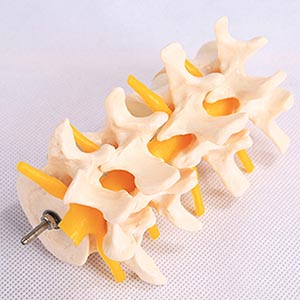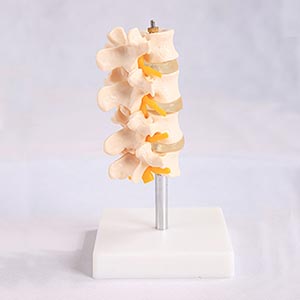09-12-2024
ADA MED SUPPLY LIMITED
Article tag: Lumbar model bone model BIX-A1017
Did you know that the lumbar spine, a key part of the human spine, not only carries most of the movements in life, but also carries almost 60% of the body weight? These five small vertebrae form the basis of our health and vitality. However, in the face of complex anatomical structures, is it really enough to understand them from a plan or book text?
This is why the lumbar model has become a "must have" in medical learning. Its value lies not only in showing bones, but also in helping learners to understand anatomy and pathology more intuitively. Let's explore the unique charm of the lumbar model from the following perspectives!

What makes the lumbar model special is its high degree of simulation. The standard models on the market today, for example, are typically made of durable materials such as polyurethane or high-density plastic, and are capable of accurately restoring the details of each vertebra, including the vertebral body, vertebral arch, intervertebral discs, and foramina.
Some high-end models even come standard with a detachable design that allows students to freely assemble vertebrae and discs to see how the pieces fit together. According to Research in Anatomy Teaching Techniques, 80% of students believe that learning anatomy using the lumbar model is easier to understand than traditional text description [Source: an anatomy Research survey].
The human brain is naturally good at processing image information, and the lumbar spine model is like turning a complex anatomical map into a "3D printed work". Imagine this: You're faced with an anatomy textbook. The text might say, "The lumbar spine is the part of the spine that connects the thoracic vertebra to the sacrum, with a disc in the middle."

That's true, but when you hold the model in your hand, everything becomes instantly clear:
- Why is the lumbar spine stronger than the thoracic spine? If you touch the model, it needs to support a lot more weight.
- How does a disc get stuck between vertebrae? As you can see from the model, its flexibility allows us to bend and stretch freely.
This hands-on experience not only "visualizes" complex concepts at once, but also helps you memorize them.
Of course you can! According to the statistics of a medical teaching reform project in a university, the average score of students in the anatomy exam increased by 15% after the introduction of anatomical model teaching. What's more, 80 percent of students reported that the interactive teaching of the models helped them "truly understand the three-dimensional structure of the human body."

Another surprising finding was that students not only had an easier time mastering the knowledge when learning with the lumbar model, but were also better able to apply it to the clinic. For example, by looking at a model of a herniated disc, students can quickly understand the causes of lumbar pain and how to treat it.
The usefulness of the lumbar spine model is not limited to the classroom, it is often used by doctors to explain the condition to patients. Imagine a patient with pain due to a herniated lumbar disc, and he or she may have absolutely no understanding of what a "disc" actually is and why it is causing the problem.
At this point, the doctor can visually show the lesion with a model: "Here is your herniated disc, and it is pressing on a nearby nerve root, so you feel pain in your leg." Such explanations are clearer than mere verbal communication, and the patient's sense of trust is improved.

In fact, clinical studies have shown that doctors who use model-assisted communication are trusted by their patients more than 30% more than doctors who simply use verbal explanations [Source: a Medical Communication study].
There are a wide variety of lumbar models on the market, ranging from basic anatomical models to advanced models with lesion examples. So how to choose the right one?
- ** Beginners ** : It is recommended to choose a basic normal lumbar assembly model, which is affordable and focuses on familiarity with the anatomy.
- ** Clinician ** : Choose models with lesion examples, such as designs with added disc herniation or bone hyperplasia, for patient education and case analysis.
- ** Teaching use ** : Can consider the modular design of the model, convenient for students to disassemble and assemble, increase hands-on ability and learning interest.
There is reason to believe that in the near future, lumbar models will become a standard tool for every medical learner, opening the door to anatomy and clinical practice.
In general, the lumbar model is a key to learning and understanding the mysteries of the human body, which not only improves the learning effect, but also makes medical knowledge more vivid and interesting. Haven't touched the lumbar model yet? Try it and feel the wonderful experience of holding the "secret of the human body" in your hand!